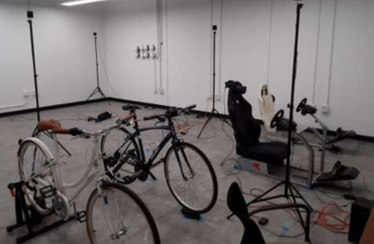Driving Simulator Study Conducted in New Mexico Explored Impacts of Automated Vehicle Communication Strategies on Human Behavior, and Perceptions in Surveys.
Albuquerque, New Mexico, United States
Autonomous Vehicle Communication Strategies Modeled in Virtual Reality
Summary Information
Benefits associated with highly automated vehicles (AV) can depend on factors such as adoption and acceptance, particularly with respect to perceptions and trust by human road users. Researchers in New Mexico explored the impacts of methods for AVs to convey intent on human road users’ perceptions and behaviors using Virtual Reality (VR) technology. Specifically, the impact of different external Human-Machine Interface (eHMI) designs on understanding, task load, comfort, trust, acceptance, and reaction time of other road users were studied using simulators. Ten participants from the University of New Mexico community engaged in a total of 310 VR trials in the study.
Methodology
Fully immersive, three-dimensional VR scenarios were created for a simulation where human participants interacted with AVs at typical urban or suburban intersections. Each participant encountered each eHMI design being assessed in each of three simulators, which allowed the participant to experience scenarios as a driver, a pedestrian, or a bicyclist (Figure 1). Outcomes of the experiments were grouped into two categories: perceptions and behaviors. Perceptions included understanding, trust, comfort, and acceptance. Understanding was measured by pausing the experiment and asking the participant whether they believed the AV would or would not stop for them. The participant’s perceptions were measured by a post-experiment survey. Trust was measured through the Scale of Trust in Automated System, a validated survey instrument. Comfort was measured through a widely used survey instrument that measured the likeability and perceived safety of robots. Acceptance was measured through the Assessment of Acceptance of Advanced Transport Telematics survey. Behaviors were measured using video capturing users’ body movements to better understand human interaction time while interacting with AVs, tracking primarily the response time. The comfort, trust, and acceptance surveys were on the same seven-point Likert scale and can be compared directly. The study also administered the National Aeronautics and Space Administration Task Load Index to each participant after each trial.

Findings
- Overall, when the cases with and without eHMI were compared, the increases in trust and acceptance were large. On a seven-point scale, average perception of trust increased from 2.75 without an eHMI to 4.85 when the eHMI was present (+2.10 points). Average acceptance responses increased from 2.29 without eHMI to 4.73 with eHMI (+2.44 points).
- In the scenarios where the AV yielded to participants, the presence of an eHMI resulted in a 3.69 second reduction in average participant reaction time. Reaction times averaged 6.51 seconds when the AV did not have an eHMI, versus 2.82 seconds with an eHMI.
- The text-based eHMI on the grille and the text-based eHMI on the driver door received the best perception scores in understanding, comfort, trust, and acceptance. The LED Windshield eHMI rated significantly worse than the others for most categories.
